When people think of South Dakota, they think of geographical features such as the Badlands or Mount Rushmore. After all, its nickname is The Mount Rushmore State in honor of the famous monument. The state is famous both for its tourism and agriculture and features a plethora of plants and animals including elk and mountain lions. South Dakota is also home to a wide variety of spiders. From orb weavers to wolf spiders, here is a list of 10 spiders in South Dakota that you can find in Mount Rushmore State.
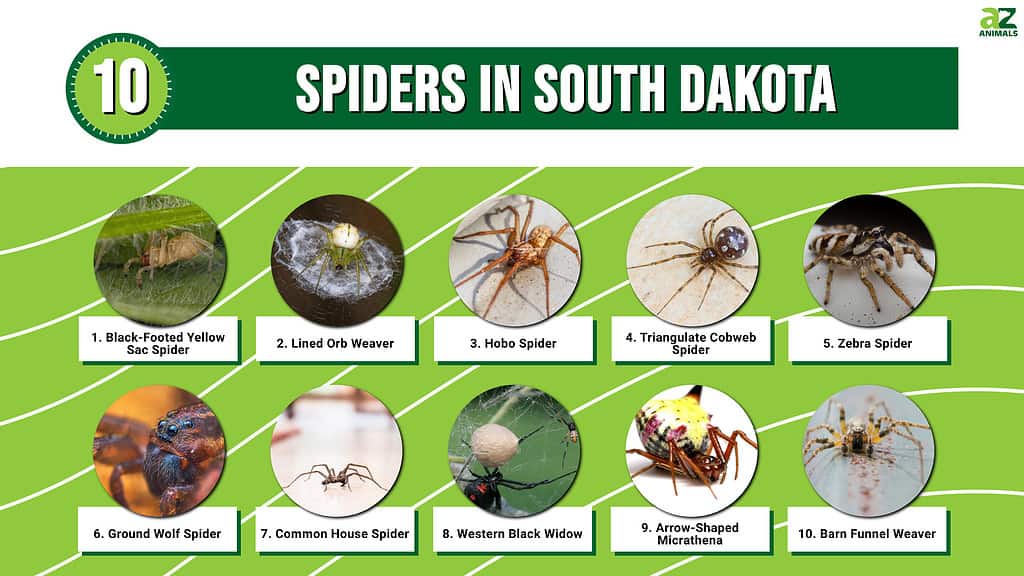
#10. Barn Funnel Weaver
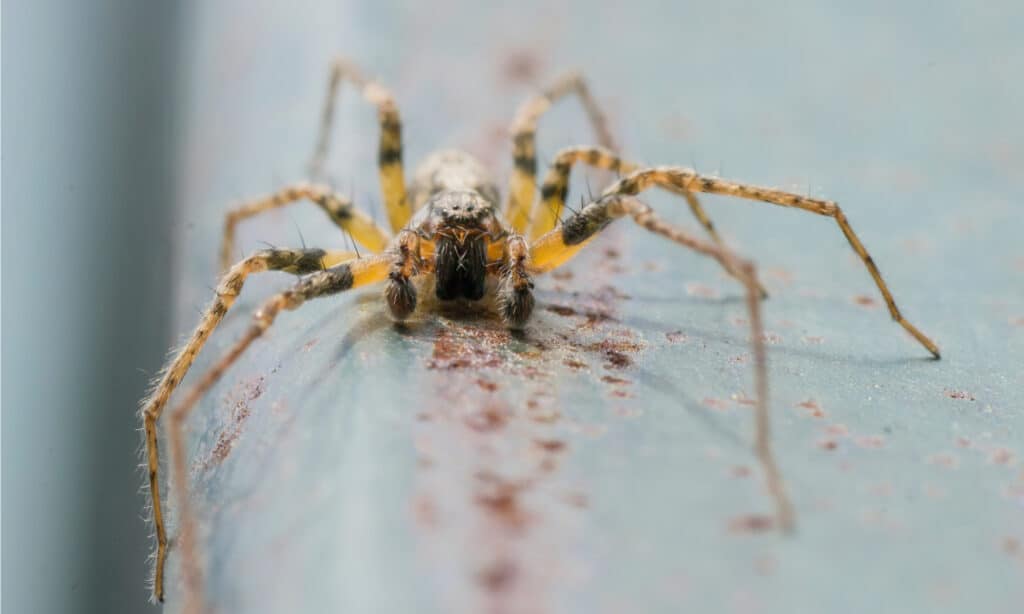
The barn funnel weaver is phobic to light.
©Korovko Gleb/Shutterstock.com
Tegenaria domestica, or the barn funnel weaver, is one of the most common spiders in South Dakota. It belongs to the funnel-web spider family Agelenidae, and also goes by the name the domestic house spider in Europe. You can find it throughout much of the world.
Adult females measure from 7 to 11 millimeters long, while males measure 6 to 9 millimeters long. Overall, the body appears rather long, and the abdomen is more straight than rounded. They look primarily light brown, except for the abdomen, which looks more grey-brown. Additionally, they feature a stripe down the center of the cephalothorax and dark markings on the abdomen.
As their name implies, barn funnel weavers make funnel-shaped webs that they use to catch prey. You can often find them in dark areas such as barns or sheds and they tend to run away from light. Their bite is not medically significant.
#9. Arrow-Shaped Micrathena
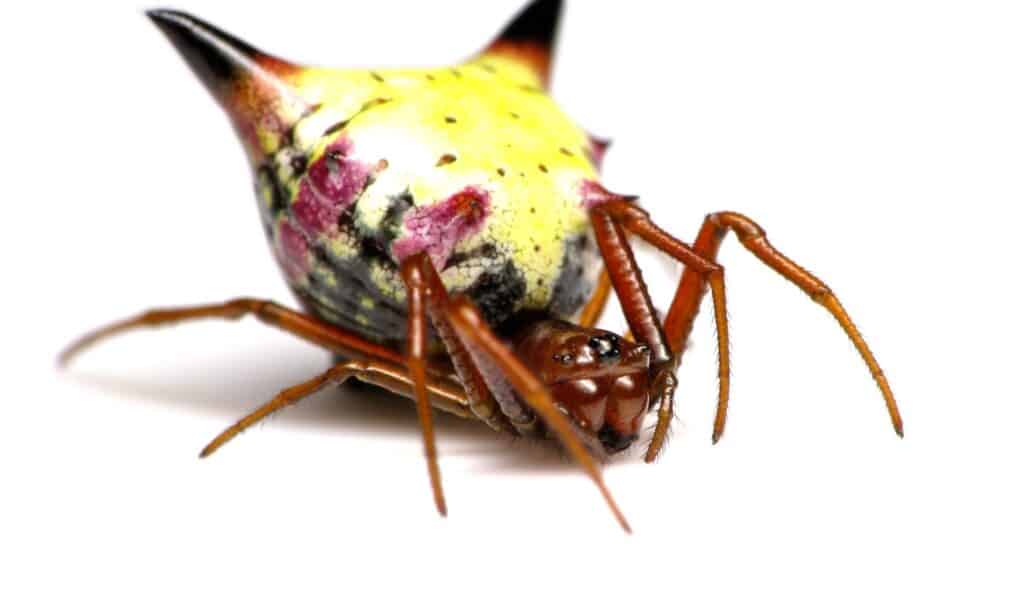
The arrow-shaped micrathena possesses an arrow-shaped abdomen, hence its name.
©Sean McVey/Shutterstock.com
The arrow-shaped micrathena, Micrathena sagittata, is a member of the orb weaver family Araneidae. You can find these spiders in South Dakota and throughout the eastern United States and Central America.
Female arrow-shaped micrathenas can grow up to 9 millimeters long, while males only measure up to 5 millimeters long. The abdomen appears bright yellow with a black border on the top and black and red markings on the bottom. They feature three black and red-tipped nodules at the base of the abdomen. These nodules make the abdomen appear arrow-shaped, hence their name. In Latin, sagittata translates to “arrowed” or “in the form of an arrow.”
Arrow-shaped micrathenas build orb-shaped webs that they use to catch their prey. Their bite is not medically significant.
#8. Western Black Widow
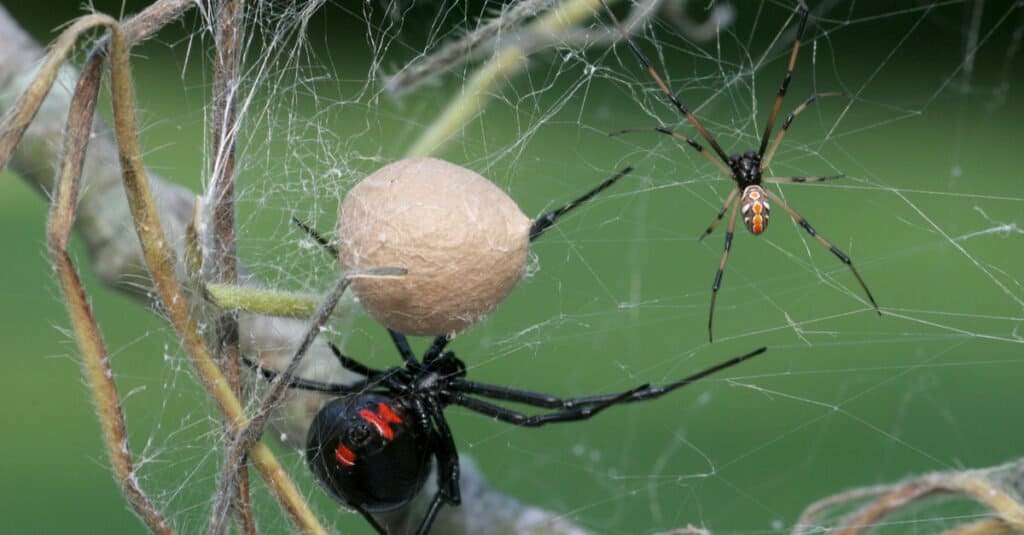
The western black widow possesses potent neurotoxic venom.
©Mark_Kostich/Shutterstock.com
You’re more likely to know Latrodectus hesperus by its common name, the western black widow. It belongs to the cobweb spider family Theridiidae and is one of the most venomous spiders in South Dakota. It ranges throughout most of western North America.
Adult females measure from 14 to 16 millimeters long. Meanwhile, males usually measure around half that size. They look primarily black aside from an hourglass-shaped marking on the top of the abdomen. The marking typically looks red, but can also appear yellow or white.
Western black widows make tangled cobwebs that they use to catch their prey. Unlike other widows, females rarely cannibalize males after mating. While they rarely bite people, their neurotoxic venom can pack quite a punch. Common bite symptoms include pain, nausea, and fever. More serious medical complications occasionally arise, but usually only in especially young or immunocompromised people.
#7. Common House Spider
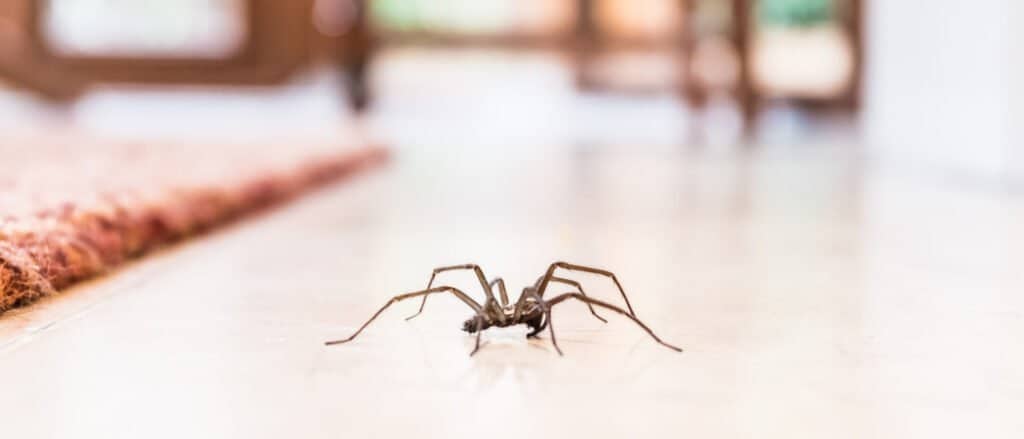
Common house spider preys on insects and other pests.
©Christine Bird/Shutterstock.com
The common house spider, Parasteatoda tepidariorum, also belongs to the cobweb spider family Theridiidae. It also goes by the name the American house spider and is one of the most common spiders in South Dakota. You can find it throughout much of the world.
Adult females typically measure between 5 and 6 millimeters long, and males measure 4 to 5 millimeters long. They vary in color from tan to black and sport various markings on the abdomen. People often confuse them for black widows due to their similar color, shape, and size.
Common house spiders get their name from the fact that they often make their irregularly shaped cobwebs inside human dwellings. They prey on a wide variety of insects and other household pests. Generally speaking, they aren’t aggressive by nature and rarely bite people. Their bite is not medically significant.
#6. Ground Wolf Spider
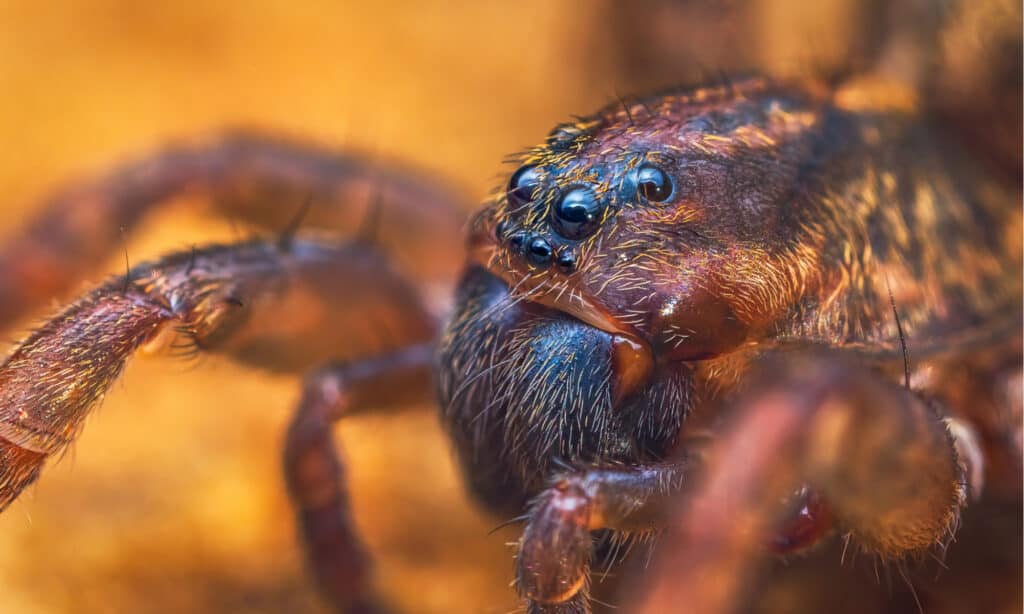
The ground
wolf spider
is an active hunter.
©Lukas Jonaitis/Shutterstock.com
Trochosa terricola, or the ground wolf spider, is a member of the wolf spider family Lycosidae. You can find ground wolf spiders in South Dakota as well as throughout the northern United States, Canada, and Europe.
Female ground wolf spiders range from 7 to 14 millimeters long, while males measure 7 to 9 millimeters long. The abdomen of the females looks reddish-brown, while the males sport dark front legs. Both sexes possess distinctive short lines on the carapace and a light cardiac-shaped marking on the abdomen.
Ground wolf spiders are active hunters that do not use webs to trap their prey. They typically roam through leaf litter and over rocks in grasslands and woodlands in search of food. Their strong legs and jaws help them to chase down and overpower their prey. You’re most likely to encounter them at night. Their bite is not medically significant.
#5. Zebra Spider
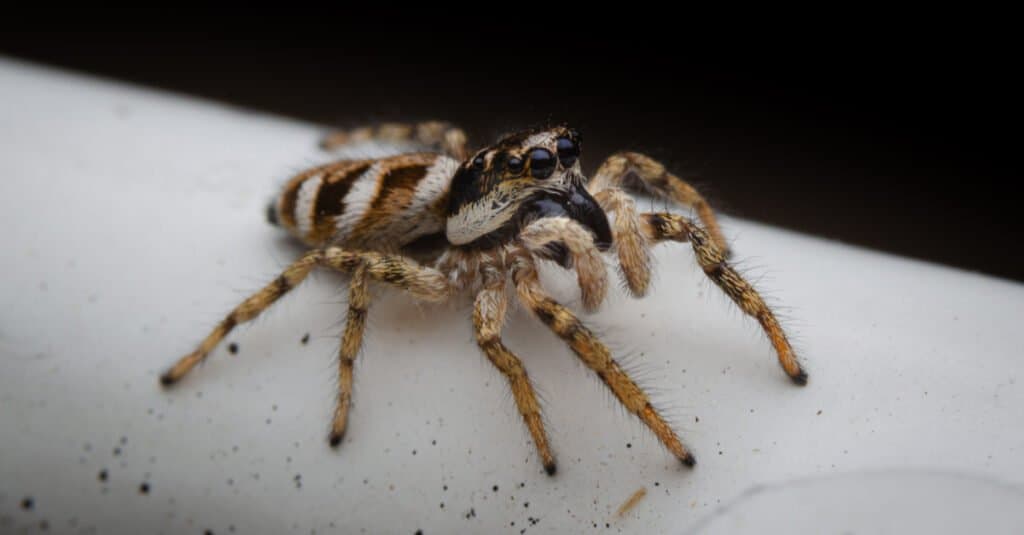
The zebra black spider has excellent binocular vision.
©Mario.Pieper/Shutterstock.com
The zebra spider, Salticus scenicus, belongs to the jumping spider family Salticidae. It ranges through much of North America and typically lives in or near human dwellings.
Female zebra spiders measure from 5 to 9 millimeters long, while males measure between 5 and 6 millimeters long. They are one of the most unique-looking spiders in South Dakota. Zebra spiders get their name from their distinctive black and white stripes that resemble the stripes on a zebra. They also feature large eyes and chelicerae or mouthparts like other members of their family.
Zebra spiders do not use webs to capture their prey. Instead, they are agile and active hunts they rely on their excellent eyesight and jumping ability. They often ambush their prey and can kill spiders and other insects up to 3 times their size. Their bite is not dangerous to humans.
#4. Triangulate Cobweb Spider

The triangulate cobweb spider has poor eyesight, so relies on vibration to detect when prey enters its web.
©Timelynx/Shutterstock.com
Steatoda triangulosa, or the triangulate cobweb spider, is the third member of the family Theridiidae to make our list of spiders in South Dakota. It also goes by the name the triangulate bud spider. It ranges throughout North America, Europe, Russia, and New Zealand.
Female triangulate cobweb spiders measure from 3 to 6 millimeters long, while males measure slightly smaller. The cephalothorax looks brownish-orange, while the yellow legs are covered in tiny hairs. They feature a purplish-brown zigzag marking down the middle of the abdomen, which is where they get their name.
Triangulate cobweb spiders make tangled cobwebs that they use to snare prey. They possess poor eyesight, so rely on sensing vibrations to know when prey stumbles into their webs. Their bite poses no danger to humans. Many people consider them beneficial spiders because they often prey on more deadly spiders such as brown recluses.
#3. Hobo Spider
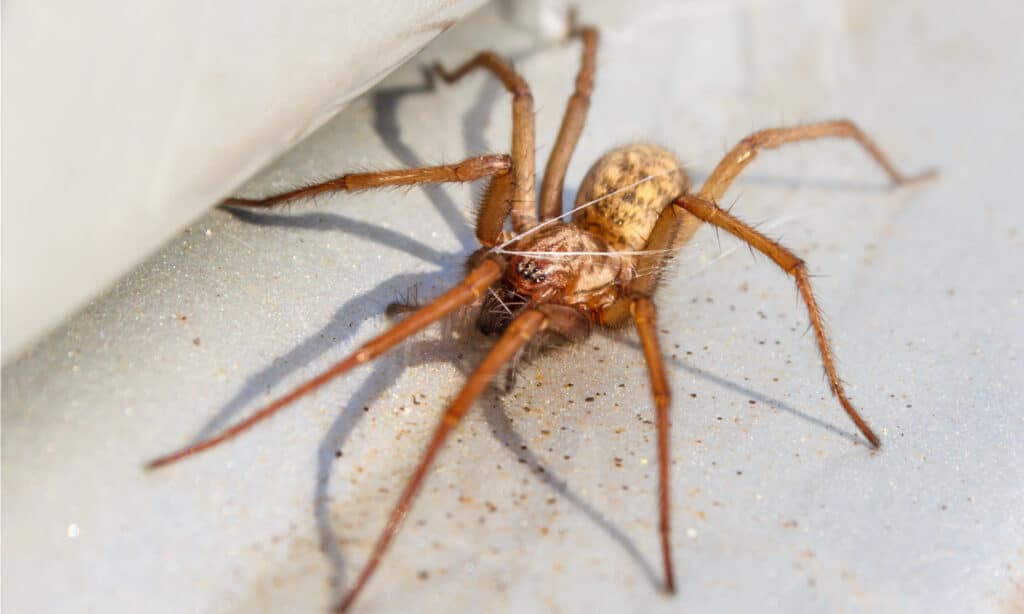
People believe the hobo spider hitches a ride on cars on trains.
©Andrew Balcombe/Shutterstock.com
The hobo spider, Eratigena agrestis, belongs to the family Agelenidae. You can find it throughout much of Europe, Asia, and western North America.
Adult hobo spiders measure between 7 and 14 millimeters long, with males measuring slightly smaller. They look almost uniformly brown aside from several light V-shaped markings in the middle of the abdomen. Additionally, they often sport a light stripe down the center of the sternum.
Hobo spiders get their name from the urban myth that they spread by hitching rides on cars and other vehicles. They build trampoline-shaped webs in fields that they use to catch their prey. In general, they avoid human contact. That said, they are one of the most misunderstood spiders in South Dakota because people mistakenly think they are dangerous. In reality, their bite is not medically significant.
#2. Lined Orb Weaver
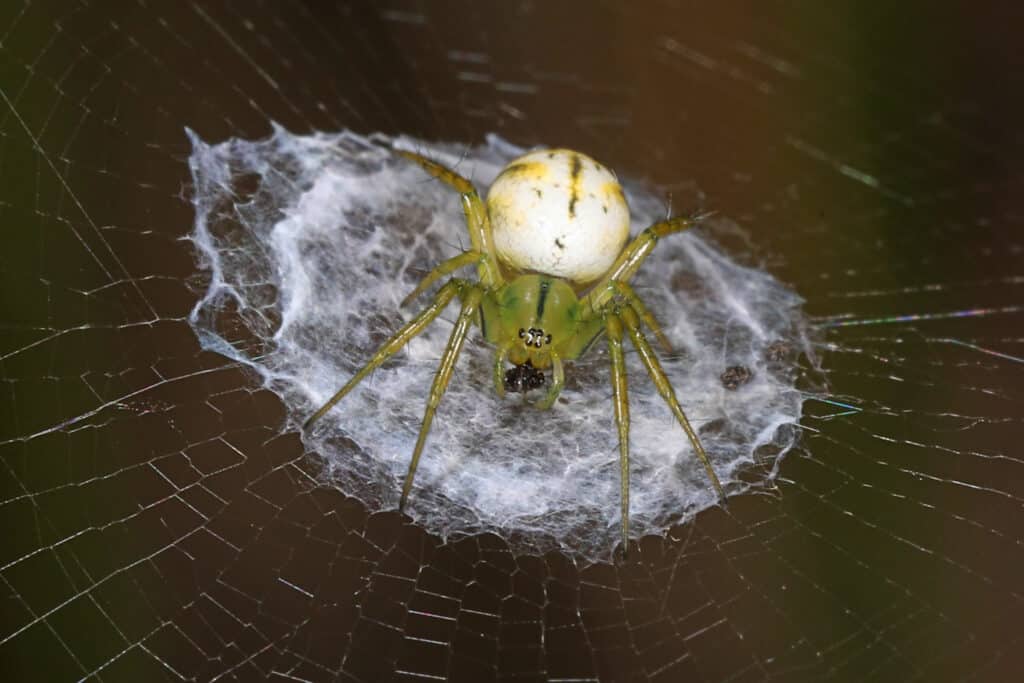
The lined orb weaver is often mistaken for the similar-looking orchard spider.
©Judy Gallagher / flickr – License
The lined orb weaver, Mangora gibberosa, is the second orb weaver to make our list of spiders in South Dakota. You can find it throughout most of eastern North America.
Female lined orb weavers measure from 5 to 6 millimeters long, while males measure slightly smaller. They range in color from white to light green. Meanwhile, the abdomen features green or yellow markings. They possess thin, practically translucent legs covered in long spines. People sometimes mistake them for orchard spiders, but you can tell them apart by the two characteristic lines down the center of the carapace, hence their name.
Lined orb weavers make unique orb webs that they use to catch their prey. The web contains an inner circle made of thicker silk that helps to stabilize it and protect it from damage. Their bite is relatively harmless to humans.
#1. Black-Footed Yellow Sac Spider
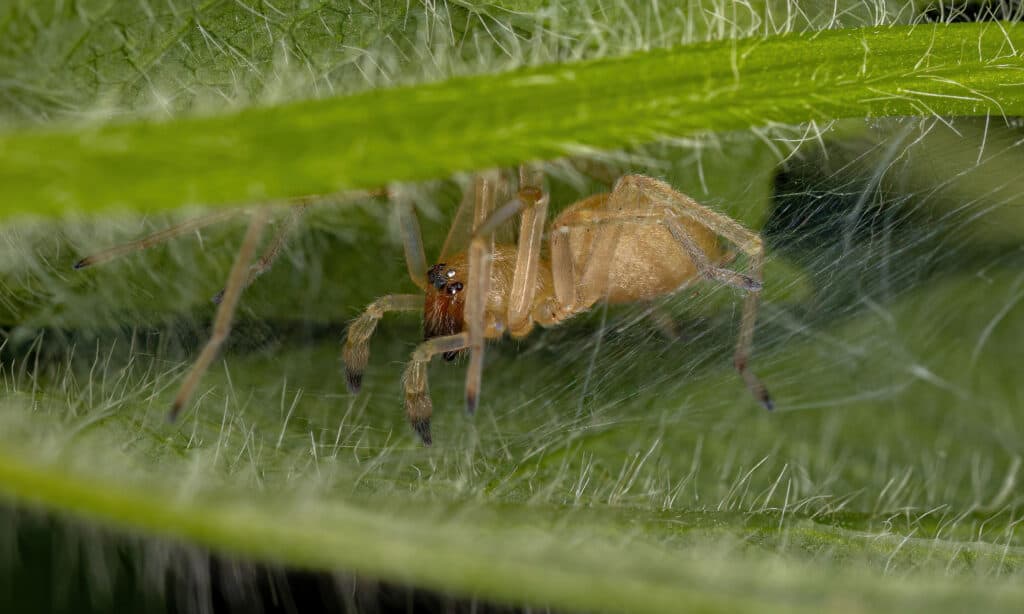
The black-footed yellow sac spider builds a silk sac to protect itself from predators during the day.
©iStock.com/ViniSouza128
Cheiracanthium inclusum, or the black-footed yellow sac spider, belongs to the family Cheiracanthiidae. It also goes by the name the American yellow sac spider. You can find these spiders in South Dakota and throughout much of North and South America.
Adult females measure between 5 and 9 millimeters long, and males typically measure 4 to 8 millimeters long. They look predominantly pale yellow and feature dark brown markings on their jaws and feet, hence their name. Meanwhile, the abdomen often sports an orange-brown stripe down the center.
Blacked-footed yellow sac spiders do not use webs to catch prey. They hide in silken retreats during the day and then emerge at night to actively hunt for food. You can often find them climbing a single silk strand like a rope bridge. Additionally, they sometimes ride this silk through the wind like a balloon.
Summary of 10 Spiders in South Dakota
Here’s a recap of the 10 spiders found in South Dakota that we took a look at.
| Number | Spider | Scientific Name | Range |
|---|---|---|---|
| 1 | Black-Footed Yellow Sac Spider | Cheiracanthium inclusum | Throughout much of North and South America |
| 2 | Lined Orb Weaver | Mangora gibberosa | Throughout most of eastern North America |
| 3 | Hobo Spider | Eratigena agrestis | Europe, Asia, and western North America |
| 4 | Triangulate Cobweb Spider | Steatoda triangulosa | North America, Europe, Russia, and New Zealand |
| 5 | Zebra Spider | Salticus scenicus | Much of North America |
| 6 | Ground Wolf Spider | Trochosa terricola | Throughout the northern United States, Canada, and Europe |
| 7 | Common House Spider | Parasteatoda tepidariorum | Throughout much of the world |
| 8 | Western Black Widow | Latrodectus hesperus | Ranges throughout most of western North America |
| 9 | Arrow-Shaped Micrathena | Micrathena sagittata | Throughout the eastern United States and Central America |
| 10 | Barn Funnel Weaver | Tegenaria domestica | Throughout much of the world |
The photo featured at the top of this post is © Sari ONeal/Shutterstock.com
Thank you for reading! Have some feedback for us? Contact the AZ Animals editorial team.






